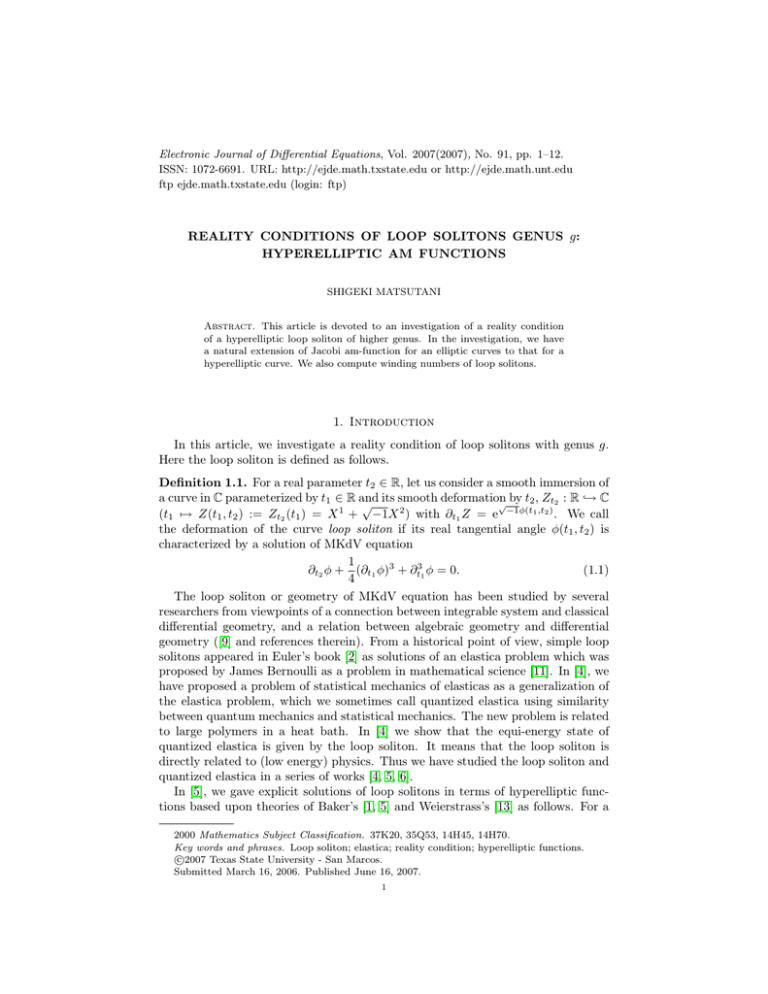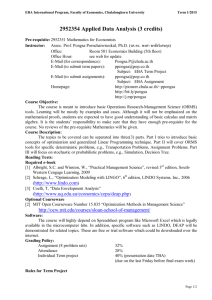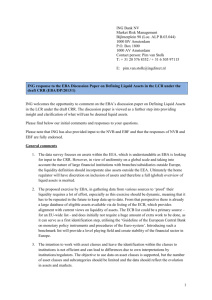Electronic Journal of Differential Equations, Vol. 2007(2007), No. 91, pp.... ISSN: 1072-6691. URL: or
advertisement

Electronic Journal of Differential Equations, Vol. 2007(2007), No. 91, pp. 1–12.
ISSN: 1072-6691. URL: http://ejde.math.txstate.edu or http://ejde.math.unt.edu
ftp ejde.math.txstate.edu (login: ftp)
REALITY CONDITIONS OF LOOP SOLITONS GENUS g:
HYPERELLIPTIC AM FUNCTIONS
SHIGEKI MATSUTANI
Abstract. This article is devoted to an investigation of a reality condition
of a hyperelliptic loop soliton of higher genus. In the investigation, we have
a natural extension of Jacobi am-function for an elliptic curves to that for a
hyperelliptic curve. We also compute winding numbers of loop solitons.
1. Introduction
In this article, we investigate a reality condition of loop solitons with genus g.
Here the loop soliton is defined as follows.
Definition 1.1. For a real parameter t2 ∈ R, let us consider a smooth immersion of
a curve in C parameterized by t1 ∈ R and its smooth deformation
by t2 , Zt2 : R ,→ C
√
√
1
2
−1φ(t1 ,t2 )
(t1 7→ Z(t1 , t2 ) := Zt2 (t1 ) = X + −1X ) with ∂t1 Z = e
. We call
the deformation of the curve loop soliton if its real tangential angle φ(t1 , t2 ) is
characterized by a solution of MKdV equation
1
∂t2 φ + (∂t1 φ)3 + ∂t31 φ = 0.
(1.1)
4
The loop soliton or geometry of MKdV equation has been studied by several
researchers from viewpoints of a connection between integrable system and classical
differential geometry, and a relation between algebraic geometry and differential
geometry ([9] and references therein). From a historical point of view, simple loop
solitons appeared in Euler’s book [2] as solutions of an elastica problem which was
proposed by James Bernoulli as a problem in mathematical science [11]. In [4], we
have proposed a problem of statistical mechanics of elasticas as a generalization of
the elastica problem, which we sometimes call quantized elastica using similarity
between quantum mechanics and statistical mechanics. The new problem is related
to large polymers in a heat bath. In [4] we show that the equi-energy state of
quantized elastica is given by the loop soliton. It means that the loop soliton is
directly related to (low energy) physics. Thus we have studied the loop soliton and
quantized elastica in a series of works [4, 5, 6].
In [5], we gave explicit solutions of loop solitons in terms of hyperelliptic functions based upon theories of Baker’s [1, 5] and Weierstrass’s [13] as follows. For a
2000 Mathematics Subject Classification. 37K20, 35Q53, 14H45, 14H70.
Key words and phrases. Loop soliton; elastica; reality condition; hyperelliptic functions.
c
2007
Texas State University - San Marcos.
Submitted March 16, 2006. Published June 16, 2007.
1
2
S. MATSUTANI
EJDE-2007/91
hyperelliptic curve Cg given by an affine equation,
Cg :
y 2 = x2g+1 + λ2g x2g + λ2g−1 x2g−1 + · · · + λ2 x2 + λ1 x + λ0
= (x − e1 )(x − e2 )(x − e3 ) . . . (x − e2g )(x − e2g+1 ),
(1.2)
where each ea is a complex number C, we have a coordinate system in a complex
vector space Jg∞ := Cg as maps from Abelian universal covering of symmetric
product of Cg , USymg (Cg ) to Jg∞ :
ug−1 =
g
X
(i)
ug−1 ,
ug =
i=1
(i)
ug−1
Z
(x(i) ,y (i) )
=
∞
g
X
u(i)
g ,
(1.3)
i=1
xg−2 dx
,
2y
u(i)
g
Z
(x(i) ,y (i) )
=
∞
xg−1 dx
.
2y
(1.4)
Proposition 1.2. A hyperelliptic solution of the loop soliton of genus g is give by
∂t1 Z (a) =
g
Y
(x(i) − ea ),
(1.5)
i=1
where t1 = Kug and t2 = K(ug−1 − (λ2g + ea )−1 ug ) for a constant positive number
K, if the curve (1.2) and integrals contours which satisfy the reality condition,
(1) |∂ug Z (a) | = R for a constant positive number R,
(2) ug ∈ R.
The proof or this proposition can be found in [5, Proposition 3.4].
However, we did not deal with explicit expression of its reality conditions in [5]
Thus we will concentrate on the reality condition of loop soliton in this article. The
reality condition of soliton equations were investigated well [[8, 3] and references
therein] but these investigations can not be directly applied to our problem. On
the other hand in [7], Mumford gave natural results on the reality condition of the
elastica and a loop soliton of genus one. In other words, he showed the moduli of
loop solitons of genus one as elasticas in terms of θ functions, or the geometry of
the Abelian varieties of genus one. However when one considers its straightforward
extension to general genus case, he encounters a difficulty. In the higher genus
case, there appears a problem that the moduli of the Abelian varieties differs from
the moduli of Jacobian varieties, i.e., a problem that there are excess parameters
in the Abelian varieties. On the other hand, on the investigation of loop soliton
even with higher genus, we have chosen the strategy that we use only the data of
curves themselves to avoid the problem of excess parameters, and give some explicit
results in [5, 6]. Thus we will go on to follow the strategy to investigate the reality
condition.
To use the strategy, we will, first, interpret the results of Mumford in terms of
the language of the curve in the case of genus one. After then, we will apply the
scheme to the reality condition of higher genus case. Section two is devoted to
the reinterpretation of Mumford results. Section three gives the moduli of the loop
solitons of genus two, which can be easily generalized to higher genus cases as in §4.
As we will show in Theorem 4.4, the reality condition is reduced to the following
conditions.
Theorem 1.3. Let a set of the zero points eb of y in (1.2) be denoted by B. Z (a)
satisfies the reality condition if and only if the following conditions satisfy,
EJDE-2007/91
REALITY CONDITIONS
3
(1) each ec ∈ B is real,
(2) there exists g pairs (ecj , edj )j=1,...,g satisfies (ecj − ea )(edj − ea ) = e2a for
negative ea ,
(3) the contour in the integral ug in (1.3) satisfies a certain condition.
Using our result of this article, we give in principle explicit solutions of the loop
solitons, even though the numerical problems might remain to illustrate its shape
graphically. Though [12] illustrated shapes of large polymers in terms of elliptic
functions as approximations, our results of this article promises to steps to exact
solutions of such shapes.
In the investigation, we have a natural extension of Jacobi am-function for an
elliptic curves to that for a hyperelliptic curve. We also compute winding numbers
of loop soliton.
As there are so many open problems related to this as in [6, 9], this result could
be applied to them.
2. Genus One
First we consider the genus one case using data from the curve given by
y 2 = x3 + λ2 x2 + λ1 x + λ0
= (x − e1 )(x − e2 )(x − e3 ).
The coordinate u of the complex plane J1∞ := C is given by,
Z (x,y)
dx
.
du, du =
2y
(2.1)
(2.2)
It is known that a shape of the (classical) elastica, i.e., a loop soliton
with genus
√
√
one, Z : R ,→ C (u 7→ Z(u) = X 1 (u) + −1X 2 (u)) with ∂u Z = e −1φ satisfies the
differential equation,
1
a∂u (φ) + (∂u φ)3 + ∂u3 φ = 0,
(2.3)
3
where ∂u := d/du.
Proposition 2.1 (Euler [2]). A solution of (2.3) is given by
∂u Z (a) = (x − ea ),
for an elliptic curve given by the form (2.1). If it is a loop soliton if an only if it
satisfies the reality condition:
(1) |∂u Z (a) | = 1.
(2) u ∈ R.
For a proof of the above propositions, see [5, Proposition 3.4].
Proposition 2.2 (Mumford [7]). The moduli Λ of elastica or loop soliton of genus
one is given by the following subspace in the upper half plane H := {z ∈ C | =z > 0}
modulo PSL(2, Z),
√
1 √
+ −1R>0 ∪ ∞ modulo PSL(2, Z).
Λ := −1R>0 ∪
2
Here R>0 is {x ∈ R | x > 0}.
4
S. MATSUTANI
EJDE-2007/91
Though Mumford led this result using the geometry of Abelian variety of genus
one [7], we will give another proof only using the language of curve itself as mentioned in Introduction. The purpose of this section is to give its proof using only
the data of the curve itself.
√
Lemma 2.3. For different numbers a, b and c in {1, 2, 3}, let e2 −1ϕa := (x −
√
ea )/ccba , eab := ea − eb and ccba := eca eba . The elliptic differential of the first
kind (2.2) up to sign is
dϕa
du = q
.
√
√
√
( eba − eca )2 + 4 eba eca sin2 ϕa
Proof. Direct computations give
√
√
dx = 2ccba −1e2 −1ϕa dϕa ,
q
√
√
√
√
2 −1ϕa − c−1 e )
y = ccba −1e2 −1ϕa eba (e−2 −1ϕa − ccba e−1
ba )(e
cba ca
q
√
√
√
= ccba −1e2 −1ϕa eba + eca − 2 eba eca cos 2ϕa ,
up to sign. The addition formula cos(2ϕ) = 1 − 2 sin2 ϕ leads the result.
Let us use the standard representations,
√ √
2 −1 4 eba eca
k := √
√
eba − eca
and then
dϕa
p
du = √
.
√
( eba − eca ) 1 − k 2 sin2 ϕa
(2.4)
By letting w := sin(ϕa ), (2.4) becomes
dw
p
du = √
√
( eba − eca ) (1 − w2 )(1 − k 2 w2 )
(2.5)
Remark 2.4. (1) Due to the (2.4), we have the following elliptic integral u(ϕa )
Z ϕa
dϕ
,
u(ϕa ) =
[1]
0
Ha (ϕ)
and its inverse function ϕa (u) gives
√
√
exp( −1ϕa (u)) = x − ea .
p
As (e3 − e1 )/(x − e3 ) is sn-function, ϕa (u) is essentially the same as Jacobi-am
function am(u) [10], though we need Landen-transformation.
(2) Behind (2.5), there is a kinematic system with an energy
E = ẇ2 + (1 − w2 )(1 − k 2 w2 ).
Due to the reality condition, Proposition 2.1 (1), ϕa belongs to a subregion
of a real number. For any ϕa in a certain region [ϕl , ϕu ], the reality condition,
Proposition 2.1 (2), requires that the denominator in (2.5) should be real and thus
√
√
√
that k 2 , or eba eca and ( eba − eca )2 , should be real;
√
√
= eba = = eca , arg(eba ) = − arg(eca ),
EJDE-2007/91
REALITY CONDITIONS
5
Figure 1. Geometry of Contours: α and β are Homology basis of
the elliptic curves.
where
arg(a) := = log(a) for a ∈ C. Accordingly introducing an expression eba =:
√
−1αba
βba e
, using αba ∈ [0, π) and βba ∈ R,1 the reality condition of the loop soliton
(a)
Z
require alternative cases:
(1) αba and αca vanish, i.e., eba and eca belong to R, or
(2) αba = −αca and βba = βca .
√
√
However, the second case means that ( eba − eca )2 vanishes and corresponds to
k = ∞.2 Thus we find the following lemma.
Lemma 2.5. The reality condition of the loop soliton Z (a) is reduced to two alternative cases:
√
I-1 eba > 0 and eca > 0, i.e., k ∈ −1R≥0 , w ≡ sin ϕa ∈ [−1, 1].
I-2 eba ≤ 0 and eca ≤ 0, i.e., k > 1 and w ≡ sin ϕa ∈ [1/k, 1] or w ≡ sin ϕa ∈
[−1, −1/k].
Proof. For general ϕa ∈ R, u must be real. Hence the candidates of eba ’s are
followings: (I-0) eba < 0 and eca > 0, or eba > 0 and eca < 0, (I-1) eba > 0 and
eca > 0, and (I-2) eba ≤ 0 and eca ≤ 0.
√
√
In (I-0) case ( eba − eca ) has a non-trivial angle in the complex plane, which
cannot be cancelled by the other factors. We remove (I-0) case. (I-1) is obvious.
The region of sin φa must be a subset of [−1, 1].
√ On the case (I-2), noting that
√
√
prefactor 1/( eba − eca ) generates the factor −1, we conclude that k > 1 and
sin φa ∈ [1/k, 1] or sin φa ∈ [−1, −1/k].
1Here we defined β ∈ R rather than β ∈ R
ba
ba
≥0 due to the domain of αba .
2Though it is not important, it is interesting that the second case can be reduced to the first
case, i.e., αca = 0, by transforming ϕa to ϕa − αca due to the formula in the proof in Lemma 2.3.
6
S. MATSUTANI
EJDE-2007/91
Proof of Proposition 2.2. Let us consider the geometry of the integration. Fig.1
gives an illustration of our situations, where Fig.1 (a) corresponds to case I-1 and
(b) to case I-2 in Lemma 2.5
p
I-1: The periodicity (4ω, 2ω 0 ) of (x − ea ) is given by
Z 1
dw
p
ω=
,
√
√
√
2 )(( e
(1
−
w
−
eca )2 + 4 eba eca w2 )
0
ba
Z 0 Z √−1/|k|
dw
0
)p
.
ω =(
+
√
√
√
2 )(( e
(1
−
w
−
eca )2 + 4 eba eca w2 )
0
1
ba
√
Thus ω 0 = ω + −1L[k] for general k with a certain real valued function L. On
the other hand, for k → 0, L → ∞ and for k → ∞, L vanishes. Further
√ L[k] is a
0
−1R>0 ).
continuous function of k and its range
is
R
.
Hence
τ
=
2ω
/4ω
∈
(1/2+
>0
p
I-2: The periodicity (4ω, 2ω 0 ) of (x − ea ) is given by
Z 1/k
dw
p
,
ω=2
√
√
√
2 )(( e
(1
−
w
−
eca )2 + 4 eba eca w2 )
0
ba
Z 1
dw
p
ω0 =
.
√
√
√
2
(1 − w )(( eba − eca )2 + 4 eba eca w2 )
1/k
On the other hand, for k → 0, ω → ∞ and for k → ∞, ω vanishes while ω 0 √
is a finite
number. Further ω[k] and ω 0 [k] are continuous in k. Hence τ = 2ω 0 /4ω ∈ √
−1R>0 .
Since theory of the Jacobi elliptic functions gives the fact that k 0 := 1 − k 2
gives the inversion of moduli τ → −1/τ , the constraint k > 1 in Lemma 2.5 is less
important.
p
We note that the periodicity of (x − ea ) differs from ∂u Z (a) by twice but the
difference is not so significant. Hence we have a complete proof of Proposition 2.2
based upon geometry of elliptic curve itself instead of geometry of Abelian variety
as a domain of elliptic theta function.
Remark 2.6. (1) We list its special cases for a = 1:
(a) k = 0 in I-1: its shape is a circle and its related curve is y 2 = (x−e1 )2 (x−e2 )
(b) k = ∞ in I-2: its shape is a loop soliton solution, and its related curve is
y 2 = (x − e1 )(x − e2 )2
√
(2) Since ∂s Z ≡ e
energy
−1φ
can be regarded as a harmonic map: ∂s Z : S 1 → S 1 with
I
E=
ds|∂s φ|2 .
(3) Above Lemma 2.5, we argued the angle of eba ’s. However the geometry of the
√
√
√
integrals depends only on eba eca and eba − eca rather than eba ’s themselves.
For the map ∂u Z : S 1 → S 1 , we can find index as a winding number as shown
in Fig.2. We call it index(∂u Z).
Corollary 2.7. The index(∂u Z) is given as follows.
I-1 index(∂u Z) = ±1.
I-2 index(∂u Z) = 0.
Proof. In the case I-1, since the contours w ≡ sin ϕa is [−1, 1] which is identified
with the range of sine function, ϕa becomes a monotonic increasing function of
EJDE-2007/91
REALITY CONDITIONS
7
Figure 2. The behavior of ϕ
√
u. In fact passing by w = ±1 changes the sign of 1 − w2 or cos ϕa . By paying
attentions on the orientation of the contour, we have the sign of the index. On the
other hand, in the case I-2, ϕ does not wind around√S 1 like Fig. 2(b). The branch
point (1/k, 0) does not have an effect of the sign of 1 − w2 .
3. Genus Two
In this section, we will investigate the reality condition associated with a hyperelliptic curve C2 of genus two expressed by
y 2 = x5 + λ4 x4 + λ3 x3 + λ2 x2 + λ1 x + λ0
(3.1)
= (x − e1 )(x − e2 )(x − e3 )(x − e4 )(x − e5 ),
where each ea is a complex number C. We have the coordinate system of the
complex vector space J2∞ := C2 ;
(1)
(i)
u1
(2)
(1)
(2)
u1 = u1 + u1 , u 2 = u2 + u2 ,
Z (x(i) ,y(i) )
Z (x(i) ,y(i) )
dx
xdx
(i)
=
, u2 =
.
2y
2y
∞
∞
(3.2)
(3.3)
0
Let the Abelian map Sym2 (C2 ) → J2 := J2∞ /Λ be denoted by ωA
where Λ is
∞
a lattice in J2 associated with C2 . Considering winding numbers, we will denote the Abelian universal covering of Sym2 (C2 ) by USym2 (C2 ) and its map from
USym2 (C2 ) to J2∞ by ωA .
The loop soliton solution of (3.1) is given by ∂t1 Z (a) = (x(1) − ea )(x(2) − ea ) if
it satisfies the reality condition.
√
(i)
Lemma 3.1. For different numbers a, b and c of {1, 2, 3, 4, 5}, let e2 −1ϕa :=
√
(x(i) − ea )/ccba , eab := ea − eb and ccba := eba eca . In general, the following
8
S. MATSUTANI
EJDE-2007/91
relation up to sign holds:
√
(i)
du2
√
√
(i)
(i)
(i)
−1(ccba e −1ϕa + ea e− −1ϕa )dϕa
=q
√
(i)
√
√
√
(i)
(( eba − eca )2 + 4 eba eca sin2 ϕa )ccba eda (e−2 −1ϕa − ccba e−1
da )
1
×q
(e2
√
(i)
−1ϕa
.
− c−1
cba eea )
Proof. Direct computations lead the formula.
We will find a subspace (Γ, ωA (Γ)) ⊂ USym2 (C2 ) × J2∞ which satisfies the reality condition. We note that since the reality condition is local, we need not pay
attentions upon the difference between Sym2 (C2 ) and USym2 (C2 ).
Lemma 3.2. The reality condition of the loop soliton Z (a) satisfies if and only if
(x(1) , x(2) ) ∈ USym2 (C2 ) and λ’s satisfy the following relations:
(1) |(x(i) − ea )| = Ki of a real constant Ki , (i = 1, 2),
(i)
(2) u2 ∈ R for i = 1, 2.
Proof. Proposition 1.2 leads to (x(1) , x(2) ) ∈ Γ ⊂ USym2 (C2 ) satisfying the reality
conditions is given by
K
,
(3.4)
|x(2) − ea | = (1)
|x − ea |
for a real constant K and
(2)
(1)
=u2 (x(2) ) = −=u2 (x(1) ).
(3.5)
When (3.4) is trivial, i.e., |(x(i) − ea )| = Ki of a real constant Ki , (i = 1, 2), and
both sides in (3.5) vanish, we obtain above conditions as sufficient conditions.
Thus we will consider its necessity condition. Assume that both conditions
(3.4) and (3.5) are not trivial, i.e., x(2) and x(1) are not independent. Since these
conditions (3.4) and (3.5) are real analytic ones, we must also deal with their
complex conjugate x(1) , x(2) , and so on. Due to the conditions, for example, x(2)
is a function of x(1) , x(1) , and x(2) . Of course, there is no guarantee whether there
exists such a function x(2) (x(1) , x(1) , x(2) ) and even continuity but we can assume
that they exist, at least, locally. The reality condition locally determines an open
(1)
subspace ωA (Γ) in J2∞ . Due to the dependence between x(1) and x(2) or u2 and
(2)
u2 , u1 , u2 u1 and u2 are neither independent over ωA (Γ). Hence ∂/∂x(1) |x(2) nor
∂/∂u1 |u2 do not behave well as differential operators among sections over Γ and
ωA (Γ), and should be replaced with covariant derivatives. For example, ∂/∂u1 |u2
is replaced with ∂/∂u1 − Au1 (u1 , u2 , u1 , u2 ) using an appropriate connection Au1 .
On the other hand, the loop soliton ∂t1 Z (a) is a meromorphic function over Γ and
ωA (Γ). However it is a restricted section of the J2∞ at ωA (Γ) in (3.2) and satisfies
the MKdV equation (1.1) with respect only to the differentials of u1 and u2 over
there as mentioned in Proposition 1.2. However the connection Au1 prevents that
the angle part of ∂t1 Z (a) does satisfy the MKdV equation (1.1). Hence Au1 and
Au2 must vanish.
However, the condition that Au1 vanishes means that ωA (Γ) is a flat real plane
in J2∞ = C2 and x(2) is independent of x(1) . Hence we prove this Lemma.
EJDE-2007/91
REALITY CONDITIONS
9
Remark 3.3. By letting an appropriate immersion ι : S 1 ,→ C2 , ∂u2 Z ◦ ωA ◦ ι is a
analytic map from S 1 to S 1 .
Lemma 3.4. For the situation of Lemma 3.1, the reality condition of the loop
soliton Z (a) needs ea = −ccba and ceda = ccba , and then we have the relation up to
sign,
(i)
du2
√
(i)
(i)
2 ccba sin ϕa dϕa
.
√
√
√
√
√
√
(i)
(i)
(( eba − eca )2 + 4 eba eca sin2 ϕa )(( eda − eea )2 + 4 eda eea sin2 ϕa )
=q
(i)
Proof. Due to the Lemma 3.2, ϕa is real and each factor must be real. Hence the
imaginary parts should be canceled locally. It means the conditions.
Let us introduce a representation as an extension of the standard representation
(2.4),
√ √
√ √
2 −1 4 eda eea
2 −1 4 eba eca
,
k
:=
,
k1 := √
√
√
√
2
eba − eca
eda − eea
and then
(i)
du2 =
√
(i)
(i)
2 4 eba eca sin ϕa dϕa
q
q
.
√
√
√
√
(i)
(i)
( eba − eca )( eda − eea ) 1 − k12 sin2 ϕa
1 − k22 sin2 ϕa
(3.6)
(i)
By letting w := sin(ϕa ), we have
(i)
du2
√
4 e
ba eca wdw
=p
√
√
√
√
√
√
(1 − w2 )(( eba − eca )2 + 4 eba eca w2 )(( eda − eea )2 + 4 eda eea w2 )
√
2 4 eba eca wdw
p
= √
.
√
√
√
( eba − eca )( eda − eea ) (1 − w2 )(1 − k12 w2 )(1 − k22 w2 )
(3.7)
Remark 3.5. (1) (3.7) is an elliptic integral by u = w2 due to a specialty of genus
two. It cannot be generalized to higher genus case.
(2) Due to the remark 2.4, we should be regard that (3.6) gives the integral as a
(i)
(i)
function u2 of ϕa ,
Z ϕ(i)
(i)0
a
dϕa
(i)
u2 =
[2]
(i)0
0
Ha (ϕa )
[2]
(i)
(i)
for an appropriate function H2 . Hence the inverse function ϕa (u2 ) gives the
relation,
q
√
(i)
exp( −1ϕa(i) (u2 )) = (x(i) − ea )/ccba .
(1)
(1)
(2)
(2)
(1)
(2)
Further ϕa := ϕa (u2 )+ϕa (u2 ) gives the al-function of u2 := u2 +u2 [1, 13],
√
exp( −1ϕa (u2 )) = ala (u2 ).
Accordingly, we should regard this ϕa as a hyperelliptic am-function of genus two.
10
S. MATSUTANI
EJDE-2007/91
Figure 3. Geometry of Contours: α1 , β1 , α2 and β2 are Homology
basis of the hyperelliptic curves.
(3) Behind the hyperelliptic am-functions, there is also kinematic system with a
hamiltonian:
√
√
√
√
√
√
E = ẇ2 + (1 − w2 )(( eba − eca )2 + 4 eba eca w2 )(( eda − eea )2 + 4 eda eea w2 ).
(i)
For each ϕa in a region [ϕl , ϕu ], the reality condition of the loop soliton Z (a) ,
Lemma 3.2 (2), requires that the denominator should be real and thus that kd2 , or
√
√
√
eba eca and eba − eca should be also real.
Theorem 3.6. The reality condition of the loop soliton Z (a) of genus two is reduced
to the conditions: ea = −ccba and ceda = ccba with three alternative cases:
√
II-1. eba > 0, eca > 0 eea > 0, eda > 0, i.e., k1 , k2 ∈ −1R and
√ sin ϕa ∈ [−1, 1].
II-2. eba > 0, eca > 0, eea ≤ 0 and eda ≤ 0, i.e., k1 ∈ −1R and k2 ∈ R
sin ϕa ∈ [1/k2 , 1] or sin ϕa ∈ [−1, −1/k2 ].
II-3. eba ≤ 0, eca ≤ 0 eea ≤ 0, eda ≤ 0, i.e., k1 , k2 ∈ R, (k1 < k2 ),
(a) if k2 < 1, sin ϕa ∈ [−1, 1].
(b) if k2 > 1, sin ϕa ∈ [−1/k2 , 1/k2 ].
(c) if k1 > 1, sin ϕa ∈ [1/k1 , 1] or sin ϕa ∈ [−1, −1/k1 ].
Proof. As in the case of the elliptic curves, we have the results.
Fig.3 gives an illustration of our situation, where Fig.3 (a) corresponds to II-1
and (b) does to II-2 and (c) to II-3.
In this case, we show the index(∂t1 Z).
Corollary 3.7. The index(∂t1 Z) as a winding number of the map ι(S 1 ) to S 1 is
II-1. index(∂t1 Z) = 0 or ±2,
II-2. index(∂t1 Z) = 0,
II-3. (a) index(∂t1 Z) = 0 or ±2, and (b) (c) index(∂t1 Z) = 0.
EJDE-2007/91
REALITY CONDITIONS
11
(i)
(i)
Proof. These indexes consist of those of each 2ϕa . If the index of 2ϕa is one,
(1)
(2)
that of 2ϕa is sum over i = 1, 2, ϕa = ±ϕa ± ϕa . Here ± depends upon the
orientation of contours. The computations of ϕa are essentially the same as the
genus one illustrated in Fig. 2.
4. Genus g
The computations of genus two are easily extended to higher genus loop solitons.
Let us introduce the sets, A := {1, 2, 3, . . . , 2g + 1}, Aa := A − {a} for a ∈ A,
O1 := {3, 5, . . . , 2g − 1}, and a bijection σa : {1, 2, . . . , 2g} → Aa for a ∈ A which
determines the order. We will fix the order σa for an a ∈ A.
Recalling the facts in genus two case, the direct computations give the following
lemmas.
√
(i)
Lemma 4.1. For a ∈ A, let e2 −1ϕa := (x(i) − ea )/ccba , eba := eσa (b) − ea and
√
ccba := eba eca ,
√
√
√
(i)
Da,σ
(ϕ
)
:=
( e1a − e2a )2 + 4 e1a e2a sin2 ϕ(i)
a
a )
a
1/2
√
√
Y
(i)
2 −1ϕ(i)
a − c−1 e
×
c12a eda (e−2 −1ϕa − c12a e−1
)(e
)
,
ea
12a
da
d∈O1 ,e=d+1
(i)
Na,σ
(ϕa ) :=
a
√
√
−1(c12a e
−1ϕ(i)
a
√
+ ea e−
−1ϕ(i)
a
g−1
)
.
In general, (1.4) up to sign becomes
(i)
du(i)
g =
Na,σa dϕa
(i)
.
Da,σa
Lemma 4.2. For the situations of Lemma 4.1, the reality condition of the loop
soliton Z (a) requires the conditions that ea = −ccba for any c ∈ O1 , b = c + 1 and
then we have
√
√
√
(i)
Da,σ
(ϕa ) = (( e1a − e2a )2 + 4 e1a e2a sin2 ϕ(i)
a )
a
1/2
Y
(4.1)
√
√
√
×
(( eda − eea )2 + 4 eda eea sin2 ϕ(i)
,
a )
d∈O1 ,e=d+1
√
g−1
(i)
Na,σ
(ϕa ) = 2 c12a sin ϕa(i)
.
a
These lemma can be proved along the line of the arguments for the case of genus
two.
Corresponding to Remark 3.5, we have the following remarks:
(1)
(2)
(g)
Remark 4.3. (1) Let ϕa := ϕa + ϕa + · · · + ϕa and then (1.5) is expressed by
∂t1 Z (a) = e2
as a function of ug :=
by
(1)
(2)
(g)
ug +ug +· · ·+ug .
√
ala (u) = e
√
−1ϕa
,
The hyperelliptic al-function is written
−1ϕa (u)
,
(2) ϕa can be regarded as hyperelliptic am-function of genus g.
12
S. MATSUTANI
EJDE-2007/91
We will state our main theorem as follows, which is also proved along the line of
the same arguments in the case of genus two.
Theorem 4.4. The reality condition of the loop soliton Z (a) in (1.5) can be reduced
to the conditions that there are g pairs (eb,a , eb+1,a )b∈O1 ∈ R2 satisfying −ea =
√
(i)
eb,a eb+1,a ≥ 0, and the contour of integral of each ug of i = 1, . . . , g should be
(i)
chosen so that ug is real.
Acknowledgments. The author wants to thank Prof. E. Previato, Prof. J.
McKay and Prof. Y. Ônishi for their helpful suggestions and encouragement. Especially I am grateful to Prof. J. McKay for refereing me to the book of Prasolov
and Solovyev [10].
References
[1] H. F. Baker; On the hyperelliptic sigma functions, Amer. J. of Math., Vol.XX (1898), 301–384.
[2] L. Euler; Methodus inveniendi lineas curvas maximi minimive proprietate gaudentes 1744,
Leonhardi Euleri Opera Omnia Ser. I Vol. 14.
[3] P. G. Grinevich and S. P. Novikov; Topological charge of the real periodic finite-gap sineGordon solutions, Comm. Pure. Appl. Math. , Vol.56 (2003), 956–978.
[4] S. Matstutani; Statistical Mechanics of Elastica on plane: Origin of MKdV hierarchy J.
Phys. A, Vol.31 (1998), 2705–2725.
[5] S. Matstutani; Hyperelliptic Loop Solitons with Genus g: Investigations of a Quantized Elastica, J. Geom. Phys., Vol. 43(2002), 146–162.
[6] S. Matstutani; On the Moduli of a Quantized Elastica in P and KdV Flows: Study of Hyperelliptic Curves as an Extension of Euler’s Perspective of Elastica I, Rev. Math. Phys., Vol.
15, 559-628.
[7] D. Mumford; Elastica and Computer Vision in Algebraic Geometry and its Applications,
edited by C. Bajaj, Springer-Verlag, Berlin (1993), 507–518.
[8] S. M. Natanzon; Real nonsingular finite zone solutions of soliton equations, Topics in topology and mathematical physics, Amer. Math. Soc. Transl. Ser. 2, 170, (1995), 153–183.
[9] E. Previato; Geometry of the Modified KdV Equation in Geometric and Quantum Aspects
of Integrable System, edited by G. F. Helminck, Springer-Verlag, Berlin (1993) 43–65.
[10] V. Prasolov and Y. Solovyev; Elliptic Functions and Elliptic Integrals (1991) translated by
D. Leites, AMS (1997).
[11] C. Truesdell The rational mechanics of flexible or elastic bodies 1638-1788, Leonhardi Euleri
Opera Omnia Ser. II, Vol. 11 part 2, Orell Füssli, Zürich, 1960.
[12] H. Tsuru and M. Wadati; Elastic Model of Highly Supercoiled DNA Biopolymers, Vol. 25
(1986) , 2083-2096.
[13] K. Weierstrass; Zur Theorie der Abel’schen Functionen, Aus dem Crelle’schen Journal, Vol.
47 (1854).
Shigeki Matsutani
8-21-1 Higashi-Linkan, Sagamihara, 228-0811, Japan
E-mail address: rxb01142@nifty.com




